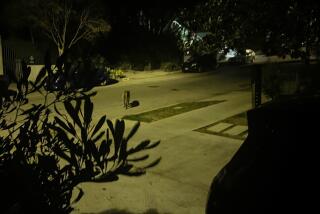Is the success of urban coyotes a sign of bigger things to come?
A mountain lion roams the streets of downtown Santa Monica until it is shot by authorities.
A black bear searches Glendale neighborhoods for meatballs until it is captured and caged.
Episodes of large carnivores entering urban areas are seemingly on the rise, and scientists say the beasts may be following a path worn by urban coyotes, as well as skunks and raccoons before them.
“We used to think only little carnivores could live in cities, and even then we thought that they couldn’t really achieve large numbers,” said urban ecologist Stan Gehrt. “But we’re finding that these animals are much more flexible than we gave them credit for and they’re adjusting to our cities.”
At a symposium Friday at Ohio State University in Columbus, Gehrt described his 12-year effort to track and study almost 700 coyotes living in and around urban areas, including Chicago.
By using radio transmitting collars, Gehrt and his colleagues were able to track the progress of the coyote communities and found that they were thriving amid plentiful food sources. The survival rate of coyote pups in urban areas is five times higher than those of rural pups, he said.
The animals, Gehrt said, were serving as a test case for larger carnivores like wolves, mountain lions and bears. It’s likely that humans will have to get used to increasing conflict between themselves and wild carnivores.
Eradication programs aimed at specific species, such as the coyote, have shown mixed results, he said.
When Gehrt’s study began in 2000, several communities around Chicago trapped and killed coyotes found within their boundaries.
“I think those programs will go away,” Gehrt said. “It costs money, and it upsets some residents who want coyotes living there. So there is conflict, cost and lack of effectiveness.”
Gehrt also questioned the efficacy of the eradication programs.
“We have great data in areas where removal was done,” he said. “You pull them out, and literally within just a few weeks, new coyotes moved in and set up new pack and began reproducing right away.”







